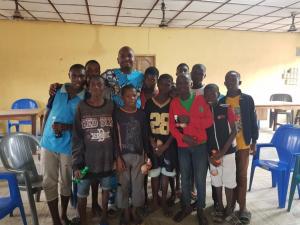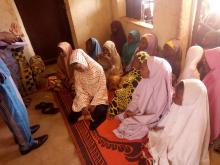The invisible boys and girls: Understanding barriers to accessing healthcare among disadvantaged Nigerian youth
Abuja, 4 September, 2018 - Ground-breaking new research is assessing the factors that prevent young people from accessing health services in Nigeria. Funded by WHO through UK Aid from the UK Government, the research will aim to strengthen efforts to reach some of the most disadvantaged youth with healthcare, and inform an ambitious new Adolescent Health Policy and implementation plan in Nigeria.
Such efforts will be crucial in a country where youth now make up close to a quarter of the total population. Evidence suggests that they often face challenges in accessing health services, especially those who are poor or otherwise disadvantaged. This includes youth living in rural areas, those with low levels of education and those in the poorest wealth quintile and young girls.
According to UN data, for example, only 15 percent of adolescent girls in the country can access the family planning services they need, compared to more than half of women aged 20-49. And even amongst adolescent girls there is a large disparity. While 76 percent of the wealthiest adolescent girls have their family planning needs met, this drops to 12 percent among the poorest group.
Identifying which adolescents are being missed and why
Over several months, the research team undertook an extensive review of studies on adolescents in Nigeria, examined large pre-existing databases in order to generate new information on adolescents, and visited communities in Sokoto, Borno and Bayelsa States, talking to 120 adolescents and 51 people who are working with young people. The evidence they uncovered provides a wealth of information on the reasons why disadvantaged youth may not be accessing health services.
For Bashiru, an adolescent boy from Maiduguri Municipal Council in Borno, the lack of access to health services is a question of availability, as some staff deprioritise treating adolescents over those considered in more need. “There is only one clinic here and mostly they only attend to infants,” he says. “The people there are always busy with treating babies and we [adolescents] are turned away when we go to the health facility.”
Shortage of staff is not the only barrier. Often lacking their own source of income, costs (both fees for services or medicines and indirect costs for transport) can have greater implications for adolescents than other age groups. This is particularly true for those with disabilities or younger adolescents, who are less often working and yet have unique health needs to be addressed.
It is not uncommon to see barriers such as cost, distance and attitudes of health workers weigh more heavily on specific, disadvantaged groups. According to a key informant interviewed for the study, street children may be exposed to trafficking and abuse, and malnutrition, and they are sometimes exploited.
“They are less likely to have time, money and the freedom to access care as needed: Adolescents in rural areas, out of school children, street children and hawkers have more financial difficulties”, he explained.
Lack of financial autonomy can also lead to dependence on family consent or chaperones for health visits. This can cause adolescents to delay or avoid seeking care, particularly where services have a stigma attached such as for substance abuse or sexual and reproductive health.
Gender and other social norms were also raised by all focus groups and many interviews as potential barriers to accessing health services. One key informant from a non-governmental organization (NGO) raised the issue of how certain practices can deter particularly adolescent girls, from going to the facility.
“If it is something like reproductive health services, they are not going to get cooperation from the nurses without being lectured and depending on the part of the country; they might have wanted her to come with an escort, a mother in law, a mother or something of that nature.”
Many of the focus groups with adolescents iterated that only same-sex health providers are culturally accepted to deliver care to girls and young women. Where the number of female nurses, community health workers and doctors are limited, as is the case in many states in northern Nigeria, access to care can be significantly hampered. All of these factors can be compounded for rural adolescents who often face unique constraints, not just related to distance to health services, but the features of rural life itself.
According to an informant from the Federal Ministry of Health, “adolescents in rural areas find it more difficult to access health services, the society is closely-knit there, and as such they don’t have the courage to access health services,” he said. “Most resort to patent medicine stores [chemists] to get whatever they need, and the patent medicine stores don’t care about counselling: they just give the drugs without being bothered about what you need it for.”
Ways forward
The study’s findings, alongside a wider situation analysis will feed into the updating of the National Policy on the Health and Development of Adolescents and Young People in Nigeria as well as its implementation plan. Both documents are drawing from WHO’s Global Accelerated Action for the Health of Adolescents (AA-HA!):
Guidance to support country implementation – which assists governments in responding to the health needs of adolescents in their countries.
“Young people are the future, and yet they are too often neglected within health services,” said Dr Wondimagegnehu Alemu, the WHO Country Representative (WR) to Nigeria. To the WR, “This research aims to shed light on the factors that prevent critical groups of young people from getting the healthcare they need, which will be an important step towards achieving universal health coverage in Nigeria.”
Undertaken in partnership with the Government of Nigeria, the research is the first country pilot of WHO’s Handbook for Conducting Adolescent Health Services Barriers Assessment (AHSBA) with a Focus on Disadvantaged Adolescents.
Kindly follow us on Social Media:





